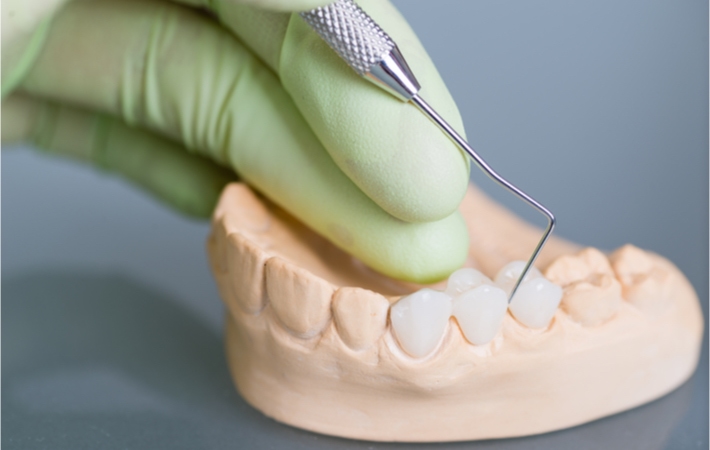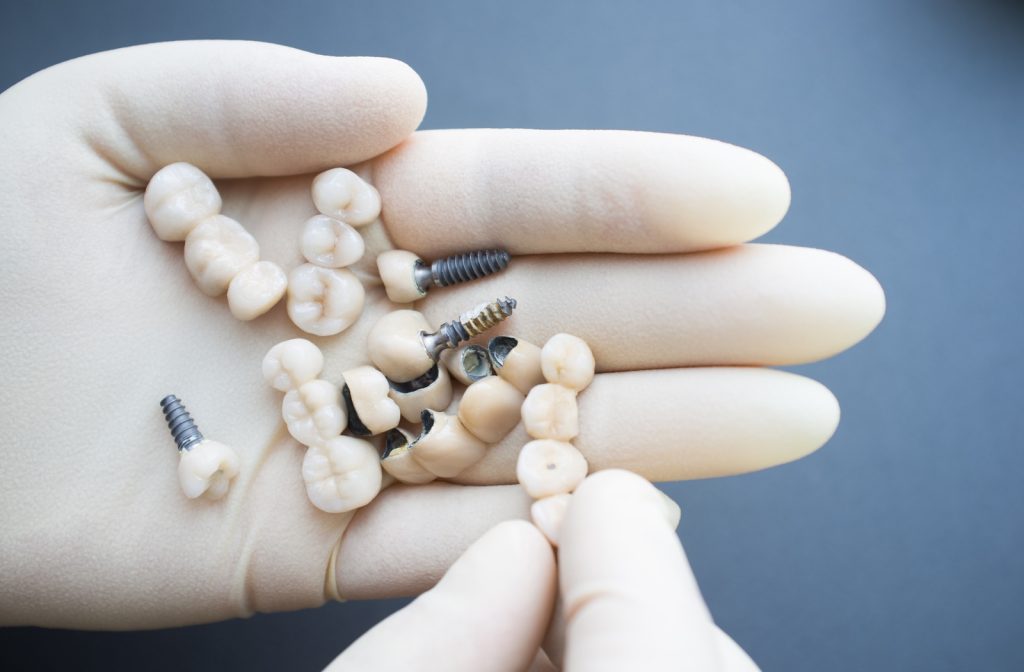What is the Difference Between Crowns, Bridges, Implants & Veneers?
If you’ve had a damaged or missing tooth before, you’ve likely heard about crowns, bridges, and other dental procedures. All of these treatments can benefit your smile, but what’s the difference between them?
Continue reading to learn the difference between crowns, bridges, implants, and veneers, including what they are, how they work, and how they differ.
What are Crowns?
If you have a damaged tooth, a crown can restore its look, shape, and function without the need for an extraction. A dental crown is a cap used to cover your damaged or decayed tooth. It restores the tooth while protecting it from further damage.
- Breakage
- Tooth decay
- Root canal
- Large fillings
Some people receive dental crowns for cosmetic purposes, such as covering a discoloured or misshapen tooth. Depending on your preference and your dentist’s recommendation, you can receive a crown in several materials, including stainless steel, gold, resin, or ceramic.
How Do You Receive a Dental Crown?
You typically receive a crown in 2 visits to your dentist’s office. The steps involved include:
- Removing decay & shaping the tooth
- Taking an impression of the tooth to create the crown
- Placing a temporary crown
- Removing the temporary crown & cementing the final product
What are Bridges?
Your teeth need to work together to help you speak and chew. When you lose a tooth, you need to replace it to maintain proper alignment throughout your mouth. One way to replace this missing tooth is with a dental bridge.
A bridge helps replace missing teeth, attaching an artificial tooth between your natural ones. Typically, bridges attach to 2 crowns, and you cannot remove them, but other types of bridges are available. You can receive fixed and removable bridges.
How Do You Receive a Bridge?
It takes between 2 to 3 appointments to attach your bridge. These steps include:
- Preparing the teeth near the missing tooth
- Taking impressions of the teeth to construct the bridge
- Providing a temporary bridge to protect your exposed teeth
- Checking & adjusting the completed bridge
- Cementing the final product into place

What are Implants?
Dental implants are an alternative to bridges or dentures if you have missing teeth. They can help restore your smile while improving functionality. Implants look and feel like natural teeth.
A dental implant is an artificial root inserted into your jawbone. Implants are titanium and act as an anchor, supporting an artificial tooth or a bridge.
To be eligible to receive a dental implant, you must be in overall good health, have healthy gums and have enough bone to support an implant. Your dentist will conduct a dental exam before recommending this procedure.
Because the implant connects directly with your jawbone, the overall process takes several months to complete. Given putting in implants does involved a significant amount of work, you may be curious about their longevity. You can explore this further in our post titled How Long Do Dental Implants Last.
How Do You Receive a Dental Implant?
The dental implant process involves 2 appointments over 6 to 8 months. These steps include:
- Placing the implant beneath your gum line
- Stitching the gums back into place
- Letting the implant bond to your bone & gums
- Attaching a small post to the implant
- Attaching the artificial tooth
What are Veneers?
If you aren’t satisfied with your smile, veneers can help. They can correct chipped, damaged, stained, or cracked teeth and improve your smile.
Veneers are thin shells that attach to the front of your teeth. They consist of porcelain or composite resin and match the colour of your natural teeth. Porcelain is usually the ideal material because of its durability and stain resistance, helping your veneers last for years. In case you are wondering ‘are veneers permanent?‘ the answer is yes, effectively, anyways. The surface of the teeth has to be altered
Your dentist can help determine if veneers are right for your needs during a dental exam. You may not be an ideal candidate if you:
- Have untreated gum disease
- Have tooth decay
- Have teeth without adequate enamel
- Grind or clench your teeth
How Do You Receive Veneers?
Porcelain veneers usually require 2 appointments to complete. The steps involved include:
- Shaping the tooth & removing precise amounts of enamel
- Creating a mould & selecting the desired colour
- Creating a rough surface for the veneer to adhere to
- Placing & gluing the veneer to your natural teeth
After understanding the purpose of each dental procedure, what’s the difference between them?
What’s the Difference Between Crowns, Bridges, Implants & Veneers?
Crowns, bridges, implants, and veneers all help address problems with your natural teeth, but they have a few differences. They mainly differ in the ways they address problems and their overall purpose.
While you may receive them for cosmetic purposes, crowns, bridges, and implants are generally restorative. They help restore the look, feel, and function of your teeth. Each procedure does this differently.
Crowns restore a single tooth by covering them with an artificial cap. Bridges replace missing teeth by attaching a pontic between 2 crowns. An implant attaches directly into your jawbone to support an artificial tooth or a bridge.
Veneers are typically a cosmetic procedure to enhance your smile, but they also have restorative benefits. Whether you require restorative or cosmetic dental care, your dentist can determine the best option for your needs. For example, at our Mississauga dentist clinic we are able to offer procedures for crowns, bridges, implants, and veneers depending on your specific needs.
Improve the Look & Function of Your Teeth
Whether you have broken, chipped, discoloured, or missing teeth, your dentist can help restore your smile. Different dental treatments can address different needs, and your dentist can recommend the best option for you. Call us today to book in with a dentist if you’re interested in learning about the difference between crowns, bridges, implants, or veneers for yourself.


